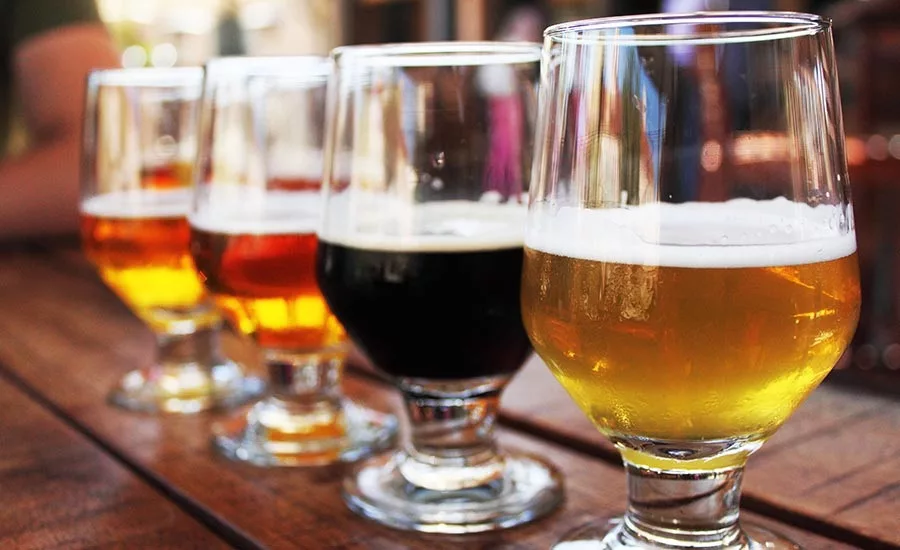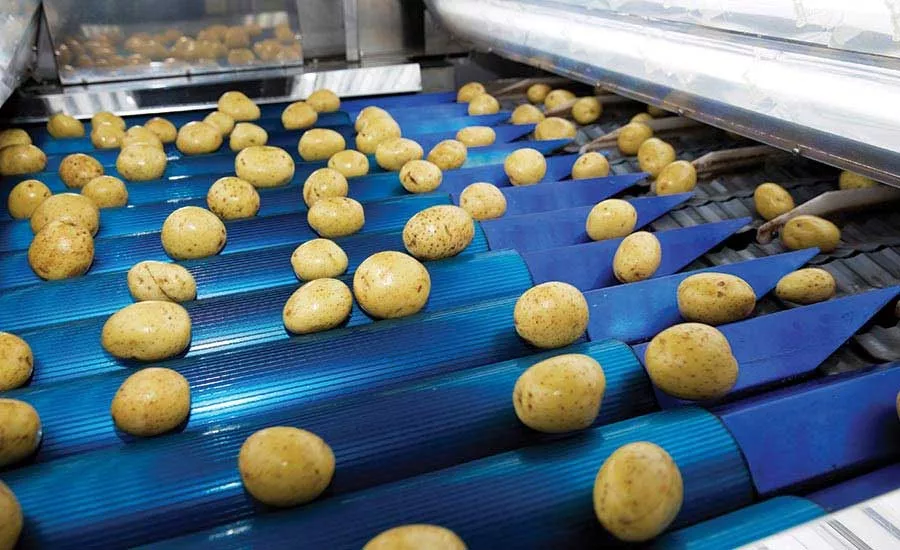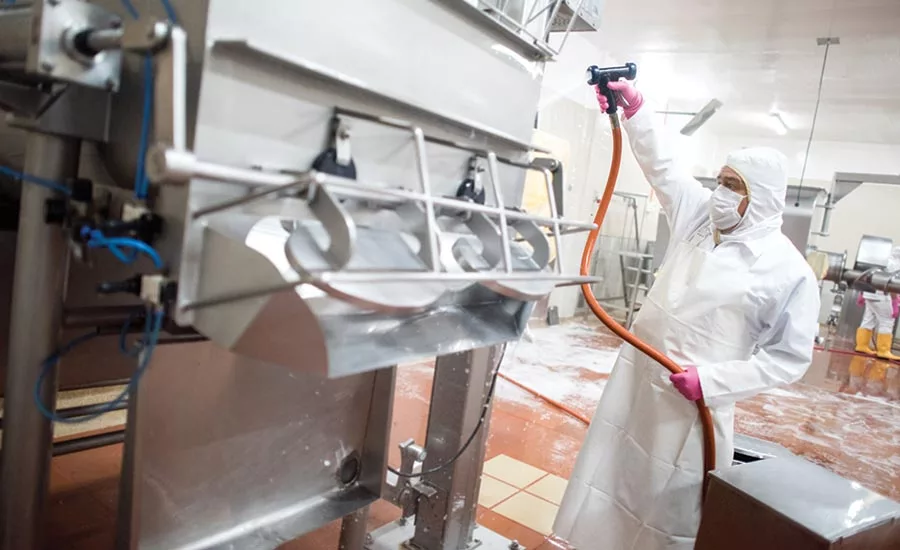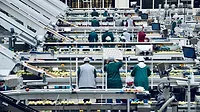Automation Series
How to get the most out of sensors
Processors can get more out of sensing technology than ever, but only if they do their due diligence.

In applications such as brewing, sensing technology offers processors consistent evaluations of qualities, such as color, while people might not notice or correctly see variations.
Photo Courtesy of iStock/dschnarrs

When raw materials need to be sorted and prepared for processing, sensors can automate the sorting and separation process.
Photo courtesy of iStock/gemenacom

Washdowns in food plants involve high-pressure hot water and caustic chemicals, which can play havoc with sensors. Specifying sensors designed for such conditions helps processors avoid bad readings or constant replacement of parts.
Photo courtesy of iStock
Imagine a glass of beer.
For our purposes, it doesn’t really matter what kind of beer it is, how cold it is or what kind of glass it’s in. But visualize a glass of beer, think about it for a minute, and then answer this question:
What color is it?
It’s a simple answer, right? Depending on the particular beer you’re thinking of, it could be “amber,” “gold,” “black,” “yellow,” “brown” or “red.” Different styles or brands would have different colors, of course, but the beer you’re imagining has a specific color. And if someone else imagined the same kind of beer, they would have the same answer.
Or would they?
Article Index:
“If you and I look at a glass of beer, our perception of the color will be different, but an optical color sensor will always give the same value,” says Ola Wesstrom, food and beverage industry manager, Endress+Hauser.
When we consider our imaginary beer again with that context, Wesstrom’s observation sums up one of the main reasons that food processors need to understand what sensing technology can do for them: People can observe things differently, but sensors don’t.
In addition to that, sensors can help ensure that automated processes are working correctly, provide feedback on production and improve quality control efforts. But as is the case with most automation decisions, food processors have to be sure that they understand what they need to do to get the most out of their sensing technology.
“Don’t force the technology; the prep work needs to happen first,” says Scott Hungerford, senior instrument and controls engineer, Burns & McDonnell. “Assess a system and how people use it—just adding smart sensors won’t solve the process problems.”
To do that prep work and understand what you need and how you need it, there are a few specific areas that need to be explored. They include understanding what your goal is, adapting to the environment and ensuring that your sensing technology and your controls system can work together.
Understanding the goal
When any investment in new or upgraded technology is made, processors start with identifying what issue they want to solve and how they want to solve it, then identify the best options available to do those things. Sensing technology is no different, says
Hungerford.
“The first step is to identify the key business metric you want to address or the loss area to fix,” he says. “Next, define the root cause of that loss and how you would fix it. From there, select technology that will help solve the issue, such as vision systems and enhanced automation of process equipment or machines.”
To go back to our beer example, the issue might be that you’re not getting a consistent color in the finished product, especially in a smaller, craft environment where everything is done by hand. While a brewmaster might be able to identify slight variations in color, a different brewmaster might not be able to, or might see even more variations. But an optical color sensor will report exactly what the differences are, allowing for fixes that can be validated by a system that you know will see the color exactly the same way every time.
Or the challenge might be at the beginning of the process, when you’re bringing in raw materials. While there will always be certain amounts of acceptable variations in raw materials, such as the size of vegetables, you’re still looking for as much consistency as possible when it comes to sorting and preparing ingredients, says Sanjay Jasoliya, senior instrument and controls engineer, Burns & McDonnell.
“For the food industry, a common challenge is sorting different shapes of the raw food, such as carrots or potatoes for the processing line,” says Jasoliya. “Using manpower to verify the consistency can be very time consuming. Vison technology can now be used to automate the process and save time.”
While those are specific examples of goals to meet, there are also general goals that are often on the radar for processors. Instead of needing improved color consistency or better material sorting, you might be looking for more efficient or consistent operations. Wesstrom explains that sensing, or measurement instrumentation, can be put into three areas as part of an automation strategy: control, monitoring and inline quality feedback.
- Control is using sensing technology for metrics, such as batching quantities and process setpoints (e.g., temperature, flow rates, pressure).
- Monitoring entails tracking consumption of resources such as gas, electricity and steam.
- Quality feedback is tracking and correcting quality parameters such as viscosity, pH, density or dissolved oxygen.
These areas can be monitored separately or together with sensing technology, and the data gathered can help inform decisions about operating strategies. The core of a sound automation strategy is communication and data management to help improve operations. Having sensing technology in place to monitor and report from all areas of operations can provide processors with the information they need to operate effectively.
“We often tell our customers that, if we can measure it, we can report it,” says Walker Mattox, managing director of GraySolutions, a Gray company. “This is key: Understanding the needs of the business when selecting sensing technology should happen at the beginning and should be the foundation of an effective automation strategy.”
Hostile Environment
One of the unique challenges of food processing as opposed to other kinds of manufacturing is the environmental challenges of selecting equipment and conducting operations. While an auto parts plant may have a consistent temperature and humidity through the entire production area, a food plant can vary widely depending on the product being manufactured, the storage requirements of raw materials and finished products, and even the airflow requirements for ensuring allergens don’t cross-contaminate products that are not supposed to contain those allergens.
And we haven’t even mentioned cleaning yet. But it’s an important consideration, because it can affect the operating environment in a number of ways. Chemicals can destroy sensors if they aren’t designed to resist harsh substances, and humidity can play havoc with readings. All of these environmental challenges have to be kept in mind when it comes to specifying and using sensors, says Ryan Beat, PE, senior electrical engineer, associate, SSOE Group.
“Specifying sensors that are able to operate in the harsh environments of daily chemical cleaning with very hot water sprayed from high-pressure nozzles is always challenging,” says Beat. “Fortunately, the manufacturers we deal with are constantly researching and designing their sensors to operate in these areas.”
Beat points out several ways that manufacturers are adjusting to those environmental challenges, such as pressure transmitters that can survive 600 psi steam or power supplies and barriers to reduce the chance of explosions. In addition to those features, the NEMA enclosure rating and Ingress Protection value standards can help processors understand what they need in a sensor to ensure it stands up to the environment. Manufacturers are also taking steps to adapt to common challenges such as humidity.
“Humid environments are probably the hardest to deal with, and manufacturers are building small heaters into their equipment to try to keep the sensor enclosures as dry as possible,” Beat says. “Altitude can also be a factor in HVAC equipment, for example, that uses natural gas heaters, as the air to fuel mixtures are affected by the lower pressures of higher altitudes.”
Even after all of the internal environmental challenges are accounted for, there can still be oddities that affect your sensors, says Hungerford. He recently had a client that was reporting an issue with a vision system, and the irregularity was occurring at the same time every day.
“After completing an assessment of the system, we found that the sunlight through the window changed the exposure on the vision system, which could have allowed an off-quality product to go through,” he says. “In another instance, we worked with a client who learned that after setting up VFD drives on the system, it was creating enough electromagnetic interference for the metal detectors to falsely identify metal in the product. Even if the systems are separate, interference can occur, and signals can be disturbed.”
Figuring out all of these environmental challenges is a daunting task, and there will always be things such as Hungerford’s examples that pop up out of nowhere and ruin your planning. In those cases, there is often nothing you can do until the problem presents itself, then adapt to it. But if you try to nail down as many of the environmental challenges as possible, you can at least limit your reactive concerns to true outliers instead of something that should have been accounted for but was overlooked.
Control concerns
One of the challenges of reaching a consensus on what “automation” means is that every food plant has different needs, which means every food plant has different requirements for its control systems and how they interact with equipment. The good news is that, for the most part, sensing technology can be integrated into most modern control systems with a minimum of pain and suffering.
But if you’re faced with a situation where “modern” may not exactly apply to your control system, then you could be facing a different scenario. Or if your control system is newer but not all of your equipment is, then you could also be facing a more complicated process.
“Your system needs to be ready to adapt to new technology,” says Jasoliya. “Otherwise, you will pay for equipment for which you can’t use all of the functionality.”
Legacy control systems can be a headache when you’re trying to integrate any new technology, and sensing technology is no different. Depending on exactly what kind of system you have in place, you might not be able to meet your intended goals, or even adopt much in the way of sensing at all. Workarounds exist, but if you’re running a legacy system, you may end up being faced with having to upgrade or replace it to be able to take advantage of sensing technology.
But, in most cases, the odds are good that you have a control system that is at least reasonably up to date, which means you can use sensing technology to help you meet your automation, efficiency and production goals. But you still need to evaluate what you want to do, how you want to do it and how you can meet both of those goals.
“Ultimately, data is gathered from sensors to help make better decisions and to make those decisions more quickly and accurately,” says Hungerford. “It is a business benefit that is key for manufacturing. But if you don’t have the right data, you won’t reap the rewards. Pulling the information is only as beneficial as the accuracy and integrity of the data.”
As Hungerford says, no matter what your plant- or process-specific goal is, you’re going to be relying on data to meet it. So, you have to identify what data you need and what you want to do with it, then make sure that both the sensors and the control system can provide the necessary data in a format that you can use.
You can also start to add in other sources of data, such as equipment on the production line. All of the sensors and all of the equipment can quickly add up to a staggering amount of data, so keep that in mind when you’re deciding how you want the data produced and how you want to be able to manage it. Data is great, but unusable data is exactly that—unusable.
As for just how much data we could potentially be talking about, consider that if you have something automated, you’re going to want a sensor on it, and if you’ve got a sensor on it, you’re going to want the sensor to be providing steady feedback to the operators. Because if you don’t have that feedback, then you’re not really automating anything in a way that makes sense.
“Depending on the level of automation, the sensors may need to provide continuous updates 10 times a second for a controller to make automatic adjustments to a fast process, or periodic updates to a slow chart recorder that updates once every 15 minutes,” says Beat. “The accuracy and precision of the sensor is also important, as certain media and fluids may require frequent calibration to provide reliability.”
Once you’re receiving the data in a format you can handle, you can start to use it to observe and adjust your operating parameters or other elements of your production process. Using the data to identify and understand trends in production processes, operating parameters or equipment performance can help you do a top to bottom review of how your process is working and where it can be improved.
“For example, if you notice the temperature is steadily rising on a particular application like a motor, you know it will likely fail soon, causing either a bearing jam or running overload,” says Hungerford. “From there, you can avoid unplanned downtime and factor it into planned maintenance. The data helps you anticipate problems before they can occur.”
The bottom line
As is the case with most technology involved in food processing, sensing technology can do basically as much—or as little—as you want it to. But, as is also the case with most technology, clearly defining your goals, understanding your environment and paying careful attention to how you integrate sensors with the rest of your operations is critical to getting the performance, results and data that you want.
If you want to get the most out of sensing technology, then you need to do the prep work first, or you’ll be disappointed with the outcome. But if you put the time and effort into preparing for the specification and implementation of sensing technology, then it can help propel your automation efforts forward.
“Without the infrastructure put in place, your smart device won’t work with your legacy technology,” says Jasoliya. “Invest in the controls network first to maximize your investment and get the full benefit out of it.”
For more information:
Scott Hungerford and Sanjay Jasoliya, Burns & McDonnell,
www.burnsmcd.com
Randolph Wilson, Gray Construction,
www.gray.com/projects/food-and-beverage-plant-construction
Walker Mattox, GraySolutions, a Gray company,
www.gray.com/about-gray/graysolutions
Ola Wesstrom, Endress+Hauser,
www.us.endress.com/
Ryan Beat, SSOE Group,
www.ssoe.com
Looking for a reprint of this article?
From high-res PDFs to custom plaques, order your copy today!






